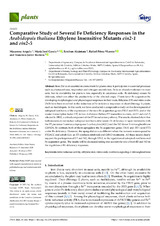Comparative Study of Several Fe Deficiency Responses in the Arabidopsis thaliana Ethylene Insensitive Mutants ein2-1 and ein2-5
Autor
Angulo, Macarena
García, María José
Alcántara Vara, Esteban
Pérez-Vicente, Rafael
Romera, Francisco Javier
Editor
MDPIFecha
2021Materia
Ferric reductase activityEthylene
Iron
Nitric oxide
Root hairs
Signaling
S-nitrosoglutathione
METS:
Mostrar el registro METSPREMIS:
Mostrar el registro PREMISMetadatos
Mostrar el registro completo del ítemResumen
Iron (Fe) is an essential micronutrient for plants since it participates in essential processes such as photosynthesis, respiration and nitrogen assimilation. Fe is an abundant element in most soils, but its availability for plants is low, especially in calcareous soils. Fe deficiency causes Fe chlorosis, which can affect the productivity of the affected crops. Plants favor Fe acquisition by developing morphological and physiological responses in their roots. Ethylene (ET) and nitric oxide (NO) have been involved in the induction of Fe deficiency responses in dicot (Strategy I) plants, such as Arabidopsis. In this work, we have conducted a comparative study on the development of subapical root hairs, of the expression of the main Fe acquisition genes FRO2 and IRT1, and of the master transcription factor FIT, in two Arabidopsis thaliana ET insensitive mutants, ein2-1 and ein2-5, affected in EIN2, a critical component of the ET transduction pathway. The results obtained show that both mutants do not induce subapical root hairs either under Fe deficiency or upon treatments with the ET precursor 1-aminocyclopropane-1-carboxylate (ACC) and the NO donor S-nitrosoglutathione (GSNO). By contrast, both of them upregulate the Fe acquisition genes FRO2 and IRT1 (and FIT) under Fe deficiency. However, the upregulation was different when the mutants were exposed to ET [ACC and cobalt (Co), an ET synthesis inhibitor] and GSNO treatments. All these results clearly support the participation of ET and NO, through EIN2, in the regulation of subapical root hairs and Fe acquisition genes. The results will be discussed, taking into account the role of both ET and NO in the regulation of Fe deficiency responses.

